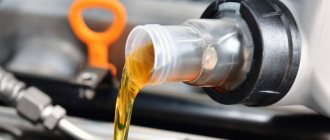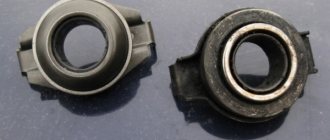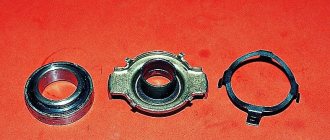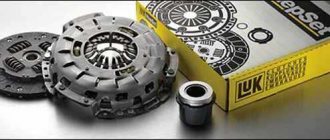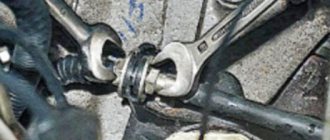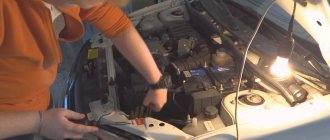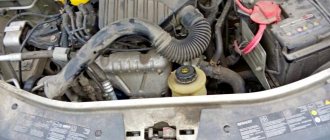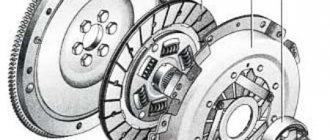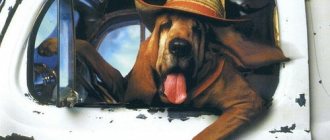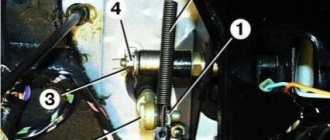Manual Transmission
In cars with manual transmission, the driver has three pedals at his disposal: gas, brake and clutch. The car starts moving only if the driver first presses the clutch pedal, selects the desired gear, releases the clutch pedal and presses the gas. Each time you change gear, the procedure is repeated.
The operation of a manual transmission in this case has a fairly simple principle: while the clutch pedal is pressed, the driven and pressure plates are open and the torque from the flywheel is not transmitted to the wheels. As soon as the pedal is released, the discs press tightly against each other and the car moves.
Thanks to the clutch, a comfortable ride is ensured for both driver and passengers. The car is maneuverable, and the gearbox and flywheel work smoothly. And this design has been in operation for decades.
But there are also weaknesses in this system. Over time, the discs wear out and no longer fit tightly together. Accelerating, braking and changing gears becomes more difficult. In this case, you need to change the clutch kit, which you can buy on the Internet or at the car market.
Advantages of DSG with wet clutch
Even at the dawn of the production of the DSG-6 DQ250, car owners often complained about the early failure of the differential, about the chips formed during the operation of the vehicle, which could “kill” the gearbox. But since 2007-2008, these problems have been completely eliminated and are encountered in practice with rare exceptions. The advantages of the “six” compared to the “seven” are obvious. Firstly, it is a more reliable clutch design. Even though the clutches wear out over time, “dust” appears, in a word - a waste product, after 150-200 thousand kilometers they remain suitable, you just need to change the oil. Secondly, a much longer service life due to design simplicity: there are known cases of a car traveling 250-300 thousand km with a DSG-6 DQ250 virtually without a single serious breakdown. At the same time, the manufacturer has assured the resource of the 7-speed preselective gearbox is equal to 300 thousand km, but in practice you need to try to drive at least 100-150 thousand km so that the solenoid does not break or the mechatronics fail.
The worst enemy of the DSG-6 DQ250 is engine chip tuning.
If you place the main emphasis on the reliability and service life of the unit, you should abandon any types of engine tuning altogether. At the VAG factory, the preselective software is configured in such a way that the gear ratios always correspond to the declared power and torque indicators of the internal combustion engine. A small part of car enthusiasts refuse the opportunity to “pump” the car’s engine, and all because the pre-selective with a “wet” clutch is intended for models with a powerful and, as a rule, turbocharged engine. The range is colossal - from 1.4-liter turbocharged units with 140 horsepower to 250-horsepower V-shaped sixes. Thanks to tuning, you can easily increase power by 40-60 horses, but even this is enough for the DSG-6 DQ250 gearbox to slowly “die” after 40-50 thousand kilometers.
Automatic transmission
There is no clutch in the classical sense on cars with an automatic transmission. There are no disks that would press closely against each other.
But the principle of gear shifting still exists. It's just implemented completely differently. Moreover, it is no less old than a manual transmission. The automatic transmission was invented more than 100 years ago.
To force the car to drive with an automatic transmission, the driver presses the brake pedal, moving the clutch lever to position D (drive). Then you need to release the brake pedal and press the gas.
The work of the driven and pressure disks here is performed by a torque converter, which operates using transmission fluid. The principle is no less simple: the rotation speed of the flywheel is transmitted to the turbines of the torque converter, which, in turn, distributes the torque to the drive wheels.
The turbines are in a sealed housing and placed in oil. And the faster the flywheel rotates, the more rotating impulse the wheels receive.
If one of the turbines starts rotating, the second one repeats it. As soon as both turbines begin to move at the same speed, they are rigidly coupled to each other.
This is a wet clutch type. Oil is used to reduce friction and ensure stable operation of the mechanism.
Thus, an automatic transmission has an “automatic” clutch, only without the use of pedals and pressure plates.
Many manufacturers produce cars with both manual transmissions and switch to automatic transmissions, for example, Hyundai: buying and replacing the clutch master cylinder is as easy as any other part.
As you know, torque from the engine is transmitted to the transmission. In this case, the transmission of torque on cars with manual transmission occurs through the clutch mechanism. Clutch is also present in robotic gearboxes. As for automatic transmissions, owners of such cars are often interested in whether there is a clutch on the automatic transmission, how it works, when to change the automatic transmission clutch, etc.
In this article, we will look at how the transmission of torque from the power unit is implemented in cars with an automatic transmission, as well as what features and differences of the clutch on an automatic transmission can be distinguished in comparison with a manual or manual transmission.
Types of drive system
What transmission drive systems do you know? Many people will now name only the mechanical and hydraulic principles. However, there are two more types:
Let's look at each clutch control principle in the table.
| Drive system | Difference |
| Mechanical | Transmission of force to the release fork via a cable by pressing the pedal |
| Hydraulic | Two cylinders (hydraulic and working) are connected by a high-pressure pipe. The pedal moves the hydraulic rod and presses on the piston at the other end. The piston presses on the oil. The oil is transferred through the tube to the working cylinder. The rod, which is located in the latter, presses on the fork. |
| Electric | Electric motor with cable. The clutch is identical to a mechanical drive |
| Combined | Combined use of the above systems (hydromechanical, for example) |
Automatic transmission and clutch
To make it clearer, let's start with the usual mechanics. The design of the clutch on such gearboxes is simple. It is based on the interaction of two disks: slave and master. In a nutshell, the driven disk is pressed against the drive disk by the force of the springs, due to which torque is transmitted from the engine.
As soon as the driver presses the clutch pedal, the discs release, moving away from each other. The transmission of torque from the internal combustion engine stops, and it becomes possible to change gears.
Then the clutch closes again and torque continues to be transmitted from the internal combustion engine to the gearbox. By the way, robotic gearboxes work on the same principle, only in this case actuators controlled by the computer are responsible for pressing the clutch and selecting/engaging the desired gear.
As a result, the connection between worn discs deteriorates, there is no proper contact between the surfaces, and the clutch begins to slip. It is not surprising that a car with a worn clutch accelerates worse, since part of the torque from the power unit is lost, gears may be difficult to engage when driving, etc.
- Now let's move on to the hydromechanical automatic transmission. Regarding this transmission and the question of whether an automatic transmission has a clutch, as well as how the gears are changed, we will immediately answer that there is no usual clutch, by analogy with a manual transmission.
In other words, the complete absence of dry discs adjacent to each other and opening at the right moment, clutch basket, release bearing, etc. At the same time, a power gap (switching off the transmission of torque from the internal combustion engine to the gearbox when changing gears) still occurs on an automatic transmission.
Also in the torque converter, an important function is performed by transmission oil (ATF), which is not just a lubricant, but a working fluid. Simply put, a torque converter can be thought of as a sealed housing in which two impellers (turbines) are installed opposite each other.
One impeller rotates thanks to the drive from the engine, then through the transmission fluid the force is transmitted to the second impeller, which also begins to rotate and transmits torque to the gearbox. Depending on the rotation speed of the first turbine, the second one will rotate at the same speed.
We also note that modern automatic machines also have the ability to lock the torque converter. When the revolutions of the driving and driven turbines are equalized, they are rigidly engaged through clutches. This solution allows you to increase the efficiency of the automatic transmission and reduce the loss of useful energy when transmitting torque.
DSG-6 DQ250 with wet clutch
The preselective gearbox with a “wet” clutch became known back in 2003. The node was developed by BorgWarner. There really isn't much in common between the DSG-6 DQ250 and the DSG-7 DQ200.
The only thing that unites the units is two clutches, two mechanics, placed in one box. In fact, the DSG-6 DQ250 is a conventional mechanics, but gear shifts occur without loss of power. The main difference between the DSG-6 and other gearboxes is the presence of two hollow input shafts, and the clutch here looks like a set of clutches placed in a basket (like on an automatic transmission).
The oil in the DSG-6 DQ250 box should be changed at least once every 60,000 km. If possible, the replacement interval for technical fluid should be reduced to 35-40 thousand km. The working volume of the unit is 7.2 l
Constant transmission of torque to the wheels is possible due to the special operating principle of the box: when changing gears, one clutch is disengaged, and the second is engaged at the same time. Clutch operation is ensured by oil pressure, again, like on an automatic machine. The oil flows through the channels and, due to pressure, compresses the clutches. The disc packs are constantly in an oil bath, which simultaneously lubricates and cools them. This design generally has a positive effect on the service life of both the clutch and the gearbox itself. This is why it is so important to timely replace the lubricant in the DSG-6 DQ250, since the stability of the entire unit depends on its condition and quality.
Let's sum it up
As you can see, the automatic transmission also has a clutch, but this mechanism is very different from the dry disc clutch on a manual transmission or robotic gearbox. In fact, the automatic transmission clutch is the torque converter.
It is also important to understand that the transmission oil in an automatic transmission is the liquid through which torque is transmitted from the drive turbine to the driven one. The oil in the gas turbine engine gets very hot, and as it ages, the properties of the transmission fluid change. For this reason, the oil in the automatic transmission must be changed in a timely manner, and its level and condition must be constantly monitored.
Finally, we note that the torque converter is also installed on the CVT variator. Although the design and principle of operation of the variator and automatic transmission are different, on a CVT the torque converter also serves as a clutch, that is, torque is transmitted from the internal combustion engine to the gearbox through the transmission oil due to the rotation of the turbines.
Why the automatic transmission kicks, the automatic transmission jerks when changing gears, jerks, jerks and impacts occur in the automatic transmission: the main reasons.
Automatic transmission slipping when changing gears: the main reasons why an automatic transmission slips. Box diagnostics, troubleshooting.
Torque converter in an automatic transmission: operating principle and main malfunctions. Signs of problems with the torque converter of an automatic transmission, repair of gas turbine engines.
The automatic transmission jerks: the main causes of jerks, kicks, and shocks in the automatic transmission. Diagnostics of faults, tips and recommendations.
A jolt in the automatic transmission, the appearance of jerks when shifting gears of the automatic transmission, jolts of the automatic transmission in place: the main reasons for such malfunctions of the automatic transmission.
The main sensors in an automatic transmission: the purpose and operating principle of automatic transmission sensors. Malfunctions of automatic transmission sensors, signs.
Many drivers who switched from manual to automatic (by the way, this lesson will be useful) ask a seemingly simple but significant question - does an automatic transmission have a clutch? Or does it not exist there at all? And how do the gears change then...
THE CONTENT OF THE ARTICLE
Of course, the average person, accustomed to driving “strictly” with a manual transmission, does not really like the automatic transmission. For his reasons, this is a really unreliable unit, but yes, a manual transmission! For centuries. But the mechanics have a not very strong unit, especially for beginners, this is the clutch, which fails “on time”. Let us recall a little the principle of operation of a mechanical “box”
Clutch structure
The clutch design consists of twelve elements. Each of them plays a follower or lead role. Let's consider only the five main elements and their functionality.
- Basket or pressure plate. It has a round appearance. In it, the car owner will find pressure springs, which are located in the center of the basket. And the dimensions are identical to the dimensions of the flywheel to which they are firmly connected. The driven disk is usually inserted between the flywheel and the platform basket.
- Driven disk. It has a radial base and a round shape. The car owner will find in it friction linings, a clutch that connects this disk and the input shaft of the machine. Damper springs are located around the driven shaft. They help reduce vibrations when changing gears.
- Friction linings are made of carbon or Kevlar threads. They can be found at the base. Fastened to the disc with rivets.
- Release bearing. It consists of a pressure pad on one side. The bearing is located on the input shaft. It is attached to the protective casing. The bearing works due to the influence of the fork on it.
Similar articles:
- Cars with automatic transmission: advantages and disadvantages of automatic transmission
- How to add oil to an automatic transmission, adding oil to an automatic transmission
- CVT or automatic. Which is better and more reliable, the main pros and cons. Also video version
- Automatic transmission torque converter operating principle signs of malfunctions and device Donut in an automatic transmission
Mechanics
As we remember, there are three pedals, if you go from right to left - the first is “gas”, the middle is “brake” and the outermost is “clutch”. In order for you to get going, you need to squeeze the clutch into gear, then releasing this pedal, press on the gas and the car goes. When changing gears, you also need to repeat this procedure.
The design is very simple - if you like, it is based on dry friction of discs. To exaggerate, under the action of its springs, the driven one is rigidly pressed against the driving disk, due to which the car moves. But as soon as you press the pedal, the discs unclench (move away from each other) and you can change gears (up, down, or neutral). This design has been working for a century, and it is indeed durable, but for beginners it is not an easy test. Often they simply overexert the pedals when switching - the discs rub and the less durable one wears out.
After such abrasion, there is no longer a strong connection (pressure), the disks begin to slip, and therefore the car loses dynamics during acceleration and just driving (if the disk is completely “killed”, it may not move, just don’t switch).
We remembered a little, but what about automatically?
What is automatic transmission and the history of its creation
An automatic transmission, or automatic transmission, is a transmission that selects the optimal gear ratio according to driving conditions without driver intervention. This ensures a good smooth ride of the car, as well as driving comfort for the driver.
Currently, there are several types of automatic transmission:
In this article, all attention will be paid to the classic slot machine.
History of invention
The basis of the automatic transmission is a planetary gearbox and a torque converter, first invented exclusively for the needs of shipbuilding in 1902 by the German engineer Hermann Fittenger. Then, in 1904, the Startevent brothers from Boston presented their version of an automatic transmission, which had two gearboxes and resembled a slightly modified mechanics.
First production GM Hydramatic automatic transmission
A car equipped with a planetary gearbox first saw the light of day under the Ford T brand. The essence of the box was smooth gear shifting using two pedals. The first included upshifts and downshifts, and the second included reverse gears.
The baton was taken up by General Motors, which released a semi-automatic transmission in the mid-1930s. The clutch was still present in the car, and the planetary mechanism was controlled by hydraulics.
Around the same time, Chrysler refined the design of the gearbox with a fluid coupling, and instead of a two-stage gearbox, overdrive was used - an overdrive gear with a gear ratio of less than one.
Automatic transmission device
The automatic transmission device is quite complex and consists of the following main elements:
The torque converter is a housing filled with a special ATF working fluid and is designed to transmit torque from the engine to the gearbox. In fact, it replaces the clutch. It consists of pump, turbine and reactor wheels, a locking clutch and a freewheel.
The wheels are equipped with blades with channels for the passage of working fluid. A lock-up clutch is necessary to lock the torque converter in specific vehicle operating modes. A freewheel (overrunning clutch) is necessary to rotate the reactor wheel in the opposite direction. You can read more about the torque converter here.
The planetary mechanism of the automatic transmission includes planetary gears, shafts, drums with friction clutches, as well as an overrunning clutch and a band brake.
The gear shift mechanism in an automatic transmission is quite complex, and, in fact, the operation of the transmission consists of executing some algorithm for turning the clutches and brakes on and off using fluid pressure.
The planetary gear, or more precisely the locking of one of its elements (sun gear, satellites, ring gear, carrier), ensures the transmission of rotation and changes in torque. The elements included in the planetary gear set are locked using an overrunning clutch, a band brake and friction clutches.
An example of an automatic transmission hydraulic diagram
The automatic transmission control unit can be hydraulic (no longer used) and electronic (automatic transmission control unit). Modern hydromechanical transmission is equipped only with an electronic control unit. It processes sensor signals and generates control signals to the actuators (valves) of the valve body, which ensure the operation of friction clutches, as well as control the flow of working fluid. Depending on this, fluid under pressure is directed to one or another clutch, including a specific gear. The TCU also controls the torque converter lock-up. In the event of a malfunction, the TCU ensures that the gearbox operates in “emergency mode”. The automatic transmission selector is responsible for switching gearbox operating modes.
The following sensors are used in the automatic transmission:
- input speed sensor;
- output speed sensor;
- automatic transmission oil temperature sensor;
- selector lever position sensor;
- oil pressure sensor.
You can read more about automatic transmission sensors here.
Automatic transmission control
The automatic transmission is controlled by the automatic transmission selector. The operating modes of the automatic transmission depend on moving the lever to a certain position. The following modes are available in the machine:
- R - Parking. Used when parking. In this mode, the transmission output shaft is mechanically blocked.
- R - Reverse. Used to engage reverse gear.
- N - Neutral. Neutral mode.
- D – Drive. Moving forward in automatic gear shift mode.
- M - Manual. Manual gear shift mode.
In modern automatic transmissions with a large number of operating ranges, additional operating modes can be used:
- (D), or O/D - overdrive - “economical” driving mode, in which automatic switching to an overdrive is possible;
- D3, or O/D OFF— stands for “disabling overdrive”, this is the active driving mode;
- S (or number 2 ) - range of low gears (first and second, or only second gear), “winter mode”;
- L (or number 1 ) - second range of low gears (first gear only).
Diagram of automatic transmission modes
There are also additional buttons that characterize the operating modes of the automatic transmission:
- Sport or Power button - gear changes occur at higher engine speeds;
- Winter or Snow button - moving from a standstill occurs from second or third gear;
- Shift lock button - the ability to unlock the selector when the engine is stopped.
Some boxes have a kick-down mode. The kick-down mode involves sharp acceleration of the vehicle by switching to a lower gear. In some cases, kick-down mode is disabled when overdrive mode is turned off.
Operating principle and service life of automatic transmission
The time required to change speed in an automatic transmission depends on the speed of the vehicle and the load on the engine. The control system calculates the required actions and transmits them in the form of hydraulic influences. Hydraulics move the clutches and brakes of the planetary mechanism, thereby automatically changing the gear ratio in accordance with the optimal engine mode under given conditions.
One of the main indicators affecting the efficiency of an automatic transmission is the oil level, which must be checked regularly. The operating temperature of the oil (ATF) is about 80 degrees. Therefore, in order to avoid damage to the plastic mechanisms of the box in winter, the car must be warmed up before driving. And in the hot season, on the contrary, cool it. The automatic transmission can be cooled by coolant or air (using an oil cooler).
Automatic transmission cross-section
The most common type is the liquid radiator. The atf temperature required for normal engine operation should not exceed 20% of the cooling system temperature. The coolant temperature should not exceed 80 degrees, due to this the atf is cooled. The heat exchanger is connected to the outer part of the oil pump housing, to which the filter is attached. As oil circulates in the filter, it comes into contact with the cooling liquid through the thin walls of the channels.
By the way, automatic transmission is considered very heavy. The weight of the automatic transmission is about 70 kg (if it is dry and without a torque converter) and about 110 kg (if it is filled).
For the automatic transmission to function properly, correct oil pressure is also necessary. The service life of the automatic transmission largely depends on this. The oil pressure should be between 2.5-4.5 bar.
The resource of an automatic transmission may vary. If in one car the transmission can last only 100 thousand km, then in another it can last about 500 thousand. This depends on the operation of the car, on regular monitoring of the oil level and its replacement along with the filter. It is also possible to extend the life of an automatic transmission by using original consumables and timely servicing of the transmission.
The design and principle of operation of a robotic gearbox with one clutch
The robotic gearbox can be with one or two clutches. A robot with two clutches can be found in the article about Powershift. We will continue talking about a single-clutch gearbox.
The robot's design is quite simple and includes the following elements:
- mechanical part;
- clutch;
- drives;
- control system.
The mechanical part contains all the components of conventional mechanics, and the operating principle of a robotic automatic transmission is similar to the operating principle of a manual transmission.
The drives that control the box can be hydraulic or electric. In this case, one of the drives monitors the clutch and is responsible for turning it on and off. The second controls the gear shift mechanism. Practice has shown that a hydraulically driven gearbox functions better. As a rule, such a box is used on more expensive cars.
The robotic gearbox also has a manual gear shift mode. This is its uniqueness - both a robot and a person can change gears.
The control system is electronic and includes the following parts:
- input sensors;
- electronic control unit;
- actuators (actuators).
Scheme of operation of manual transmission
Input sensors monitor the main parameters of the gearbox operation. These include speed, fork and selector position, pressure level and oil temperature. All data is transmitted to the control unit, which controls the actuators. The actuator, in turn, controls the operation of the clutch using servos.
In a hydraulic automatic transmission, the control system is additionally equipped with a hydraulic control unit. It controls the operation of hydraulic cylinders.
The robot operates in two ways: automatic and semi-automatic. In the first case, the box is controlled through a specific algorithm, which is set by the control unit based on sensor signals. In the second, the operating principle is identical to manual gear shifting. Gears are sequentially switched from high to low using the selector lever, and vice versa.
